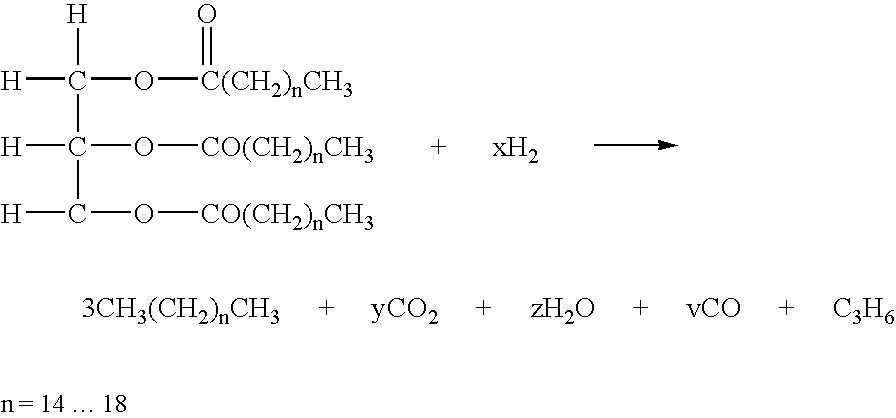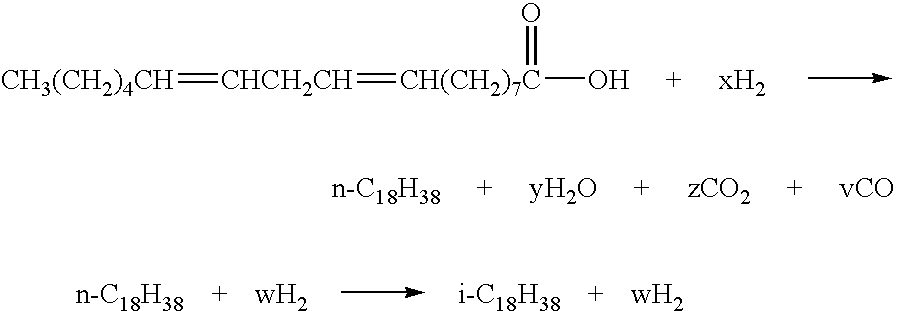Process for the manufacture of diesel range hydro-carbons
a technology of hydro-carbons and process, applied in the chemical industry, can solve the problems of hydrocarbon cracking, low amount of diesel fuel mixed products, and low number of cations but also extremely poor low temperature properties
- Summary
- Abstract
- Description
- Claims
- Application Information
AI Technical Summary
Benefits of technology
Problems solved by technology
Method used
Image
Examples
example 1
[0021] In the following, an example for conversion of vegetable oils to give high-quality middle distillate starting from the fatty acid fraction of tall oil (TOFA) is presented.
Feedstock
[0022] The feedstock comprised of TOFA having properties shown in Table 1 below.
TABLE 1Tall Oil Fatty Acid 2 (TOFA 2)Typical analysisAcid number194Saponification number195Resin acids1.9%Unsaponified2.4%Iodine number (Wijs)152Colour °G4 . . . 5Density (20° C.)0.91 kg / m3Refractive index nD201.471Fatty acid composition, % (typical)16:00.417:0 ai0.618:01.118:1 (9)30.218:1 (11)1.118:2 (5, 9)1.018:2 (9, 12)41.719:1 (9) ai0.618:3 (5.9.12)9.019:2 (5, 9) ai0.319:2 (9, 12) ai0.318:3 (9, 12 . . . 15)0.620:00.418:2 Conjugated5.518:3 Conjugated2.120:2 (11.14)0.220:3 (5.11.14)1.120:3 (7.11.14)0.2Others3.6100.0
Hydrogenation
[0023] TOFA vas hydrogenated using a normal desulphurization catalyst for middle distillates, NiMo / Al2O3. The aqueous phase was separated from the product with a separation funnel, the pr...
example 2
[0034] The catalysts were produced from the molecular sieve SAPO-11 synthetized at the NCL, in India. SAPO-11 A, and SAPO-11 B were crystallized according to the documents U.S. Pat. No. 4,440,871, and U.S. Pat. No. 5,158,665, respectively. 35% of Al2O3 was added as the support, whereas platinum (about 0.5% by weight) was added by impregnation using an aqueous Pt(NH3)4Cl2 solution.
TABLE 5Analyses of the catalystsSiO2 / Al2O3 ratio in thePt content,Catalystmolecular sieve% by weightPt dispersionSAPO-11 A0.350.5050SAPO-11 B0.450.4785
[0035] Hydrogenated TOFA feed was isomerized using above catalysts under following conditions:
Pressure50 barWHSV3−1H / HCabout 600 l / lTemperature340, 360, 370° C.
[0036] The results are presented in Table 6.
TABLE 6The product distribution in hydrogenated and isomerizedTOFA for the catalysts SAPO-11 A, and BSAPO-11ASAPO-11ASAPO-11BSAPO-11BSAPO-11BProperty340° C.360° C.340° C.360° C.370° C.Gases1.01.12.15.0(5), % by weightGasoline (nC5 1.53.92.69.616.0% by w...
example 3
[0038] A higher conversion level may be obtained by reducing the feed rate (WHSV). Isomerizations of the hydrogenated TOFA were carried out with the catalyst SAPO-11A using three WHSV values, or 1, 2 and 3 h−1. Other conditions are as in example 2. The results are presented in Table 7.
TABLE 7Influence of WHSV on the isomerizationof TOFA using SAPO-11A340° C.340° C.340° C.360° C.360° C.360° C.Property1 h-l2 h-l3 h-l1 h-l2 h-l3 h-lGases (5),2.11.11.02.33.11.1% by weightGasoline2.72.11.58.73.93.9(nC5 174° C.),% by weightMiddle95.396.997.589.093.195.0distillate(>174° C.),% by weight(n-C17 +54.933.120.192.280.363.4n-C18)conversion,% by weightIsomerization78.378.176.274.377.878.9selectivityof the middledistillatefraction, %by weight
[0039] As from the results of Table 7 may be seen, a higher conversion level is obtained both by elevating the temperature, and lowering the WHSV value. The selectivity is clearly reduced only when the conversion level exceeds the limit value of 90% by weight...
PUM
 Login to View More
Login to View More Abstract
Description
Claims
Application Information
 Login to View More
Login to View More - R&D
- Intellectual Property
- Life Sciences
- Materials
- Tech Scout
- Unparalleled Data Quality
- Higher Quality Content
- 60% Fewer Hallucinations
Browse by: Latest US Patents, China's latest patents, Technical Efficacy Thesaurus, Application Domain, Technology Topic, Popular Technical Reports.
© 2025 PatSnap. All rights reserved.Legal|Privacy policy|Modern Slavery Act Transparency Statement|Sitemap|About US| Contact US: help@patsnap.com



